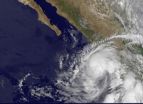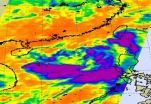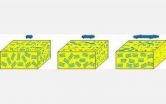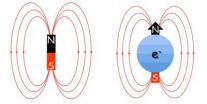The potato psyllid is the insect that transmits a bacterium that causes the relatively new disease in potatoes known as zebra chip, according to Dr. Charlie Rush, Texas AgriLife Research plant pathologist.
The team of AgriLife Research scientists and a Texas AgriLife Extension Service specialist is working on potato psyllid control and epidemiology of disease transmission under the Specialty Crop Research Initiative titled, "Management of Zebra Chip to Enhance Profitability and Sustainability of U.S. Potato Production."
This U.S. Department of Agriculture-National Institute of Food and Agriculture-sponsored initiative is led by Rush, and nationwide has a team of 20 researchers and specialists. More information about the team and their work can be found at: http://zebrachip.tamu.edu/.
At the AgriLife Research farm west of Bushland, Rush is joined by Dr. Jerry Michels, AgriLife Research entomologist, and Dr. Ed Bynum, AgriLife Extension entomologist, who are both looking at different aspects of chemical control on the psyllids.
One focus areas of the zebra chip initiative is management or control of the psyllid vector, Rush said.
"What the producers are definitely interested in is control," he said.
A large survey that monitors movement of the psyllid is headed up by Dr. John Goolsby with the U.S. Department of Agriculture in Weslaco. Selected fields from the Rio Grande Valley north to the Canadian border are sampled weekly for psyllid infestations and a weekly report is sent out to potato growers.
"Often, producers start spraying according to that report," Rush said.
The current research by Michels and Bynum is aimed at determining the most effective insecticides, as well as the best decision aids to determine when to start spraying, he said.
While they have already located psyllids in the field, they have not had the bacteria that cause zebra chip disease. Since the bacterial pathogen hasn't been detected and the number of psyllids may not have reached an economic threshold, producers may be spraying when there is no need, Rush said.
Bynum said his study is aimed at timing treatments based on different action thresholds. This would allow a reduction in the number of potato psyllids and incidence of zebra chip in the tubers, but also minimize chemical application.
His study consists of seven different treatments to determine the best time to begin spraying:
Apply chemicals, similar to the management program used by potato growers, which means a soil treatment at planting and weekly foliar sprays beginning 30 to 45 days after the soil treatment regardless of psyllid numbers. This is the "farmer control" by which all other treatments are compared. Typically, growers use one chemical for two weeks and then switch to one with a different mode of action to try to prevent resistance buildup.
Making treatments when three or more psyllids are caught on sticky traps within a week.
Sweep-net sampling and treating after at least six psyllids are caught per 10 sweeps in a field.
Testing the psyllids to see if they carry the bacterium and spraying if they do.
Spraying based on immature psyllids collected per leaf sample. Two per leaf triggers a treatment.
Treating weekly as the potato growers do, but using a special mixture of pesticides.
An untreated control against which all other treatments are compared.
The field was planted the first week of April and sampling with sticky traps and leaf samples began the second week of May, Bynum said. The first commercial application-type treatment was made the first week of June. To date, psyllid numbers have not been high enough to warrant spraying based on the action threshold treatments.
"We will carry these out until 80 to 100 days after planting, depending on the insect pressure. That will take the crop almost to harvest," he said.
"Last year we had hot psyllids (those carrying the bacterial pathogen) in both the Olton and Dalhart areas when we surveyed producers' fields for Dr. John Goolsby," Bynum said. "In our test at Bushland last year, we started with heavy psyllid pressure early in the season. This year, we are starting with hardly any. So it is unpredictable when pressure will begin and how long it lasts.
"That's why it is important to see if we can find a sampling method that allows us to better target treatments at appropriate times, instead of the current blanket method of treating throughout the growing season."
Bynum said last year's cost comparison between commercial and experimental treatments showed as much as $300 difference per acre in chemical costs.
"If we can come up with a method to make this decision, then producers can save the cost of the chemical and application, and at the same time prevent the exposure to severe incidences of zebra chip," he said.
This also helps reduce the potential for developing resistance to insecticides, Bynum said.
Michels is looking at both large-farm scale and small-plot chemical control. The current practice of chemical control is based on the grower's effort to try to get ahead of the psyllids and stay ahead, fearing that if they wait, they will get behind and not be able to catch up and lose a good portion of the production.
"What is typically being done is treatment with a neonicotinoid insecticide when potato plants emerge," he said. "That should provide protection for 30 to 40 days. Then the producers can't immediately go back with another neonicotinoid for fear of building up resistance, so we are trying to find other chemicals that will provide acceptable control."
He said they are looking at four chemical application timings: the commercial grower sequence, only when hot psyllids are found, no treatment and one quitting early.
"That's what this summer is for, to see if any of the new compounds work. And we will tie in with Ed Bynum's work," Michels said. "The long-term goal is to reduce the amount of chemicals used but be able to give the same amount of protection.
"We want to try to come up with a sequence of the proper chemicals so we won't get chemical resistance in the psyllids and also reduce the amount of chemical used."
In another study on the potato field, small tents have been erected to allow Rush and his team to inoculate plants with 30 psyllids. After allowing them one week to feed, the psyllids are killed off and then the plants are sampled weekly for the zebra chip titer.
"We want to see when the pathogen starts developing in the plant, when the disease starts expressing itself and how that relates to severity of disease in the tubers," he said.
It is possible that if psyllids come in late, even if they infect the plant, the pathogen may not have time to move to the tubers and cause zebra chip. If that is the case, then there would be no need for end-of-season insecticide applications, Rush said.
"Our long-term goal with all these studies is to develop a pest risk assessment tool that the producers can use and feel confident in."
INFORMATION:
END






